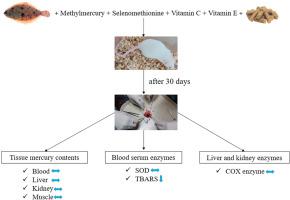Chemosphere ( IF 8.1 ) Pub Date : 2021-01-18 , DOI: 10.1016/j.chemosphere.2021.129673 Mohammad Moniruzzaman , Seunghan Lee , Youngjin Park , Taesun Min , Sungchul C. Bai

|
Mercury (Hg) in high exposures can be a potent life threatening heavy metal that bioaccumulate in aquatic food-chain mainly as organic methylmercury (MeHg). In this regard, fish and seafood consumptions could be the primary sources of MeHg exposure for human and fish-eating animals. The objective of the present study was to elucidate the effects of dietary supplementation of some antioxidants on induced mercury toxicity in mice model. In this study, a 30-day long investigation has been conducted to evaluate the dietary effect of selenium (Se) in combination with vitamin C and vitamin E on methylmercury induced toxicity in mice. Total 54 mice fed the diets with three levels of Hg (0, 50 or 500 μg kg−1) and two levels of Se in combination with vitamin C and E (Se: 0, 2 mg kg−1; vitamin C: 0, 400 mg kg−1; vitamin E: 0, 200 mg kg−1) in triplicates. The results show that Hg accumulated in blood and different tissues such as muscle, liver and kidney tissues of mice on dose dependent manner. The bioaccumulation pattern of dietary Hg, in decreasing order, kidney > liver > muscle > blood. Superoxide dismutase levels in blood serum showed no significant differences in mice fed the diets. However, dietary antioxidants significantly reduced the levels of thiobarbituric acid reactive substances in mice fed the mercury containing diets. Cytochrome c oxidase enzyme activities showed no significant differences as the mercury level increases in liver and kidney tissues of mice. Kaplan-Meier curve showed a dose- and time-dependent survivability of mice. Cumulative survival rate of Hg intoxicated mice fed the antioxidant supplemented diets were increased during the experimental period. Overall, the results showed that dietary Se, vitamin C and vitamin E had no effect on reducing the mercury bioaccumulation in tissues but reduced the serum lipid peroxidation as well as prolonged the cumulative survival rate in terms of high Hg exposures in mice.
中文翻译:

基于汞生物蓄积,抗氧化酶活性,脂质过氧化和线粒体氧化应激,评估膳食硒,维生素C和E作为甲基汞中毒小鼠的多种抗氧化剂
高暴露量的汞(Hg)可能是威胁生命的重金属,其主要以有机甲基汞(MeHg)的形式在水生食物链中生物富集。在这方面,鱼类和海鲜的消费可能是人类和食鱼动物甲基汞暴露的主要来源。本研究的目的是阐明饮食中添加某些抗氧化剂对小鼠模型中汞诱导的毒性的影响。在这项研究中,进行了为期30天的调查,以评估硒(Se)与维生素C和维生素E的饮食对甲基汞诱导的小鼠毒性的影响。共有54只小鼠用三水平的Hg(0、50或500μgkg -1)和两种水平的Se与维生素C和E结合(Se:0,2 mg kg -1; 维生素C:0,400 mg kg -1 ; 维生素E:0,200 mg kg -1),一式三份。结果表明,汞在小鼠血液和不同组织如肌肉,肝脏和肾脏组织中的蓄积呈剂量依赖性。饮食中汞的生物蓄积模式按降序排列,依次为肾脏>肝脏>肌肉>血液。饮食中的小鼠血清中超氧化物歧化酶水平没有显着差异。但是,饮食中的抗氧化剂可显着降低喂食含汞饮食的小鼠中的硫代巴比妥酸反应性物质的水平。细胞色素c随着小鼠肝脏和肾脏组织中汞含量的增加,氧化酶的活性没有明显差异。Kaplan-Meier曲线显示了小鼠的剂量和时间依赖性。在实验期间,补充抗氧化剂饮食的汞中毒小鼠的累积存活率增加。总体而言,结果表明,饮食中的硒,维生素C和维生素E不会降低组织中汞的生物积累,但会降低血清脂质过氧化作用,并延长小鼠的高Hg暴露累积累积存活率。









































 京公网安备 11010802027423号
京公网安备 11010802027423号